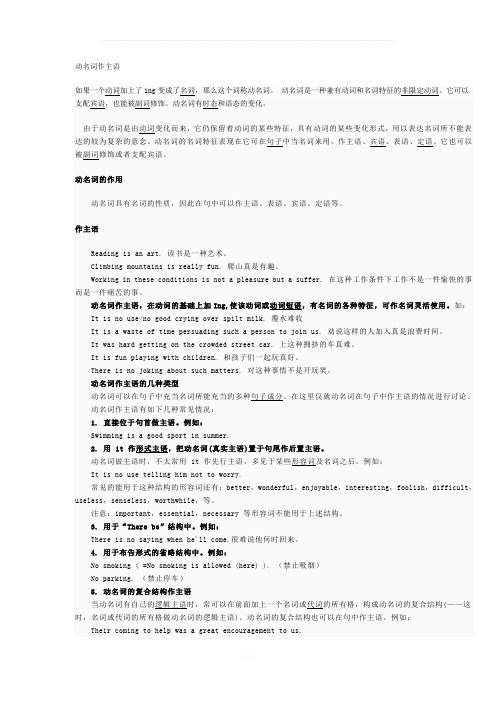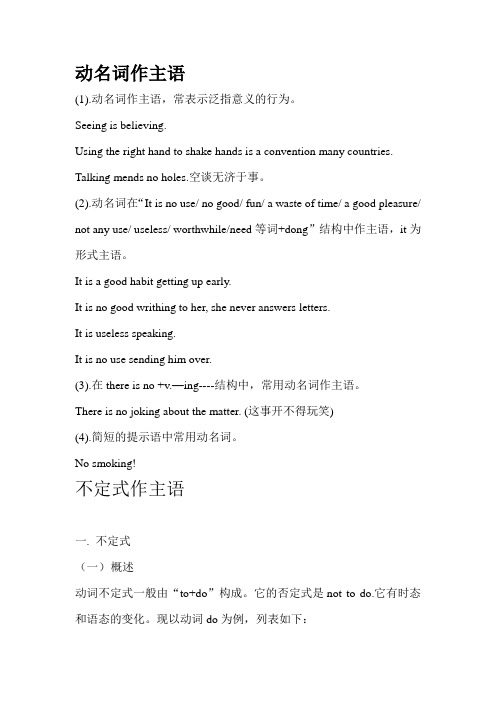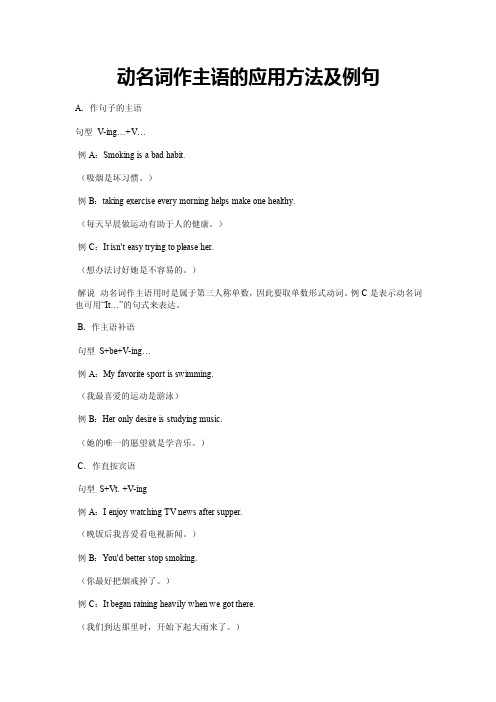动名词做主语
动名词做主语课件

详细描述
动名词在句子中作为名词性质的存在,可以 作为主语、宾语或表语,表示一个抽象的概 念或行为。而动词原形则是表示一个具体的 、一次性的动作或行为,强调动作的执行或 完成。
06
动名词做主语的练习与巩固
单项选择题练习
总结词
考察基础知识的掌握
详细描述
提供一系列关于动名词做主语的 单项选择题,让学生选择正确的 答案,以检验他们对动名词做主 语的理解和运用。
02
动名词可以作为句子的主语、宾 语、表语等成分,具有名词的语 法特征。
动名词做主语的语法规则
动名词做主语时,通常表示一个抽象 的概念或行为,强调某个动作或状态 本身,而不是动作的执行者。
动名词做主语时,通常位于句子的开 头位置,与谓语动词保持一致,使用 单数形式。
动名词做主语的特点
动名词做主语时,通常表示一个持续性的动作或状态,强调某个行为本身,而不是 行为的结果或目的。
表示一种状态或结果
状态或结果
动名词可以用来表示一种状态或 结果,如“住在城市、住在海边 ”等。这种用法通常用于描述某
个人的居住状态或环境。
句法结构
动名词做主语的句子通常采用“ 主语+谓语+宾语”的结构,谓
语动词通常为及物动词。
示例
她住在海边。 (住在作为主语表 示状态或结果)
04
动名词做主语的表达效果
05
动名词做主语的常见错误
混淆动名词和不定式
总结词
混淆动名词和不定式是常见的语法错误之一,它们在形式上相似,但用法和意义不同。
详细描述
动名词在句子中作为主语、宾语或表语使用,表示一个抽象的概念或行为,强调动作的持续性或习惯性。而不定 式则表示一个具体的、一次性的动作或行为,强调动作的执行或完成。
动名词做主语

动名词做主语、宾语精讲精练一、动名词做主语的用法动名词做主语往往表示经常性、习惯性的动作,在口语中也可以表示具体的动作。
如:Painting is his hobby.绘画是他的爱好。
Talking mends no holes.空谈无济于事。
动名词做主语和不定式做主语一样,也可以用it作形式主语。
如:It is no use talking without doing.光说不做没有用。
不定式做主语往往表示具体的特别是将来的动作。
如:It's so hot.What I want to do now is to have a swim in a river.天这么热,现在我想做的事是在河里游泳。
【考例】—What do you think made Mary so upset?— __________ her new bicycle.(1997上海高考题)A.As she lost B.LostC.Losing D.Because of losing该题正确选项为C,losing her new bicycle是句子的主语,谓语made her so upset被省略,losing...在此表示具体的动作。
二、动名词作宾语的用法1.有些动词或短语动词后常用动名词作宾语。
如admit,appreciate,avoid,can't stand(不能忍受),consider,delay,de- vote...to,dislike enjoy,escape,excuse,feel like,finish,forgive,get down to,give up,imagine,insist on,keep(on),look forward to,mention,mind,miss(错过),pay attention to,practice,put off,stick to,suggest等等。
动名词作主语

动名词作主语在英语语法中,动名词作为主语是非常常见的一种结构。
动名词是动词加上-ing形式构成的名词,它可以起到名词的作用。
在句子中,动名词经常被用作主语,下面将介绍动名词作主语的相关知识。
动名词作主语的用途动名词作主语的用途非常广泛,它可以用来说明一个行为、活动或情况。
动名词作主语有时可以用来强调或重申某个动作、活动或状态的重要性。
下面是一些例句,展示了动名词作主语的不同用法:1.Running is good for your health.(跑步对身体健康有益)2.Singing makes me happy.(唱歌让我开心)3.Swimming is a popular sport in summer.(游泳是夏季热门运动)动名词作主语的语法特点动名词作主语时,需要注意以下几个语法特点:1.作为主语,动名词单数形式通常使用动词的原形,而不是加上-s或-es。
2.动名词作主语时,通常与单数动词配合使用,而不是与复数动词配合。
这是因为动名词本身已经具有名词的特征。
3.动名词作主语时,常常需要将动词的单数或复数形式调整为第三人称单数形式。
下面是一些例句,展示了动名词作主语的语法特点:1.Dancing is my favorite hobby.(跳舞是我的最爱)2.Singing in the rain brings joy to my heart.(在雨中唱歌给我带来了快乐)3.Listening to music helps me relax.(听音乐帮助我放松)动名词作主语的常见句式动名词作主语时,常见的句式有以下几种:1.It + be + 动名词这种句式通常用于强调或描述某个活动或情况。
例: It is important to have a balanced diet.(保持均衡饮食是重要的)2.动名词 + be + 形容词这种句式通常用于说明某个活动或情况是某种状态。
例: Eating healthy is beneficial to your body.(饮食健康对身体有益)3.动名词 + 动词这种句式通常用于表达某个活动的目的或结果。
动名词作主语

如果一个动词加上了ing变成了名词,那么这个词称动名词。
动名词是一种兼有动词和名词特征的非限定动词。
它可以支配宾语,也能被副词修饰。
动名词有时态和语态的变化。
由于动名词是由动词变化而来,它仍保留着动词的某些特征,具有动词的某些变化形式,用以表达名词所不能表达的较为复杂的意念。
动名词的名词特征表现在它可在句子中当名词来用,作主语、宾语、表语、定语。
它也可以被副词修饰或者支配宾语。
动名词的作用动名词具有名词的性质,因此在句中可以作主语、表语、宾语、定语等。
作主语Reading is an art. 读书是一种艺术。
Climbing mountains is really fun. 爬山真是有趣。
Working in these conditions is not a pleasure but a suffer. 在这种工作条件下工作不是一件愉快的事而是一件痛苦的事。
动名词作主语,在动词的基础上加Ing,使该动词或动词短语,有名词的各种特征,可作名词灵活使用。
如:It is no use/no good crying over spilt milk. 覆水难收It is a waste of time persuading such a person to join us. 劝说这样的人加入真是浪费时间。
It was hard getting on the crowded street car. 上这种拥挤的车真难。
It is fun playing with children. 和孩子们一起玩真好。
There is no joking about such matters. 对这种事情不是开玩笑。
动名词作主语的几种类型动名词可以在句子中充当名词所能充当的多种句子成分。
在这里仅就动名词在句子中作主语的情况进行讨论。
动名词作主语有如下几种常见情况:1. 直接位于句首做主语。
例如:Swimming is a good sport in summer.2. 用 it 作形式主语,把动名词(真实主语)置于句尾作后置主语。
动名词做主语

动名词做主语动名词作主语1. 动名词(短语)作主语,多指抽象的、概念性的动作,可以是多次的、经常性的行为。
例如:Playing with fire is dangerous.玩火危险。
2. 动名词(短语)作主语,谓语动词通常用单数。
例如:Reading aloud is very important for us to learn a foreign language.大声朗读对我们学习外语是非常重要的。
3. 动名词(短语)可位于句首或句末,位于句末时通常用it作形式主语。
下列句型中常用动名词作主语:It+be+no use/good+doing sth.做……没有用It+be+of little use/good+doing sth.做……几乎没有用It+be+useless+doing sth.做……没有用It be worth doing/It be worthwhile to do/doing做……是值得的例如:It is no use talking without doing.光说不做没有用。
It is worth making an appointment before you go.去之前预约一下是值得的。
注意:动名词(短语)作主语时,如果要突出动名词(短语)的动作执行者,要在动名词(短语)前加上其逻辑主语,这个逻辑主语要用名词所有格或者形容词性物主代词,不能用名词的普通格或者人称代词宾格。
例如:Tom's coming won't be of much help.Tom的到来不会起到很大的作用。
辨析:不定式作主语时,一般表示具体的、个别的、一次性的或具有将来意义的动作;动名词作主语通常表示抽象的、习惯性的动作,或表示说话者对所述动作有过经验或多次做过。
例如:Getting up early is a good habit.早起是一种好习惯。
To get up early this morning made me sleepy.今天早晨起床很早使我感到困倦。
教资动名词做主语

教资动名词做主语一、动名词的概念动名词是由动词原形加 -ing构成,它既有动词的特征,又有名词的特征。
在句子中可以充当主语、宾语、表语等成分。
例如:“Swimming is my favorite sport.”(swim是动词,swimming就是动名词,在句中作主语)二、动名词做主语的用法1. 直接作主语- 表示抽象的、一般性的行为。
- 例如:Reading enriches the mind.(读书使人充实)这里的reading就是动名词,它表示“读书”这个抽象的行为,而不是具体某一次的读书动作。
- 再如:Running is good for your health.(跑步对你的健康有益)running 作为动名词,代表“跑步”这个普遍概念。
2. 动名词短语作主语- 动名词短语是由动名词加上其本身的宾语或者状语等构成的。
- 例如:Getting up early every day makes me energetic.(每天早起使我精力充沛)这里“Getting up early every day”是动名词短语,其中“up”是动名词“getting”的宾语,“early every day”是状语,这个动名词短语在句中作主语。
三、动名词作主语时的主谓一致1. 单个动名词作主语时,谓语动词用第三人称单数形式。
- 例如:Seeing is believing.(眼见为实)句中的“is”是与动名词“seeing”和“believing”相匹配的,因为单个动名词作主语,谓语要用单数。
2. 由and连接的两个动名词作主语时,如果表示的是两件不同的事情,谓语动词用复数形式;如果表示的是同一件事情或一个概念,谓语动词用单数形式。
- 例如:- Reading books and watching movies are my hobbies.(读书和看电影是我的爱好)这里“reading books”和“watching movies”是两件不同的事情,所以谓语动词用“are”。
动名词作主语

动名词作主语(1).动名词作主语,常表示泛指意义的行为。
Seeing is believing.Using the right hand to shake hands is a convention many countries. Talking mends no holes.空谈无济于事。
(2).动名词在“It is no use/ no good/ fun/ a waste of time/ a good pleasure/ not any use/ useless/ worthwhile/need等词+dong”结构中作主语,it为形式主语。
It is a good habit getting up early.It is no good writhing to her, she never answers letters.It is useless speaking.It is no use sending him over.(3).在there is no +v.—ing----结构中,常用动名词作主语。
There is no joking about the matter. (这事开不得玩笑)(4).简短的提示语中常用动名词。
No smoking!不定式作主语一.不定式(一)概述动词不定式一般由“to+do”构成。
它的否定式是not to do.它有时态和语态的变化。
现以动词do为例,列表如下:语态/时态主动形式被动形式基本用法一般式to do to be done 一般情况或未发生的动作或状态完成式to have done to have been done表示动作发生在谓语动词的动作之前进行式to be doing表示谓语动词的动作发生时,不定式的动作正在进行(二).不定式的时态和语态的用法1.不定式的时态(1)一般式:to +do它表示的动作与谓语的动作同时或几乎同时发生或是在它之后发生。
动名词作主语的应用方法及例句

动名词作主语的应用方法及例句A.作句子的主语句型V-ing…+V…例A:Smoking is a bad habit.(吸烟是坏习惯。
)例B:taking exercise every morning helps make one healthy.(每天早晨做运动有助于人的健康。
)例C:It isn't easy trying to please her.(想办法讨好她是不容易的。
)解说动名词作主语用时是属于第三人称单数,因此要取单数形式动词。
例C是表示动名词也可用“It…”的句式来表达。
B.作主语补语句型S+be+V-ing…例A:My favorite sport is swimming.(我最喜爱的运动是游泳)例B:Her only desire is studying music.(她的唯一的愿望就是学音乐。
)C.作直按宾语句型S+Vt. +V-ing例A:I enjoy watching TV news after supper.(晚饭后我喜爱看电视新闻。
)例B:You'd better stop smoking.(你最好把烟戒掉了。
)例C:It began raining heavily when we got there.(我们到达那里时,开始下起大雨来了。
)例D:I remember seeing her somewhere before.(我记得以前在什么地方见过她。
)例E:Do you mind mailing this letter for me ?(替我寄这封信你介意吗?)解说英语的Vt. 取直接宾语时,有的习惯上要取不定式,有的则要取动名词,有的则取不定式或动名词皆可,表达的意思大致相同,但是也有些表达的意思不相同,现分别介绍如下:①Vt. +V-ing …(习惯上取动名词为直接宾语)(如例A、B)admit(承认),advise(劝告),avoid(避免),consider(考虑),escape(脱逃),finish(做完),keep (on)(持续),practice(练习),quit(停止),resist(抵抗),risk(冒险),stand(忍受——否定句),stop(停止),understand(了解),etc .注:请注意下面两句表达上的差别:例:He stopped smoking. (他停止吸烟了。
- 1、下载文档前请自行甄别文档内容的完整性,平台不提供额外的编辑、内容补充、找答案等附加服务。
- 2、"仅部分预览"的文档,不可在线预览部分如存在完整性等问题,可反馈申请退款(可完整预览的文档不适用该条件!)。
- 3、如文档侵犯您的权益,请联系客服反馈,我们会尽快为您处理(人工客服工作时间:9:00-18:30)。
动名词做主语、宾语精讲精练一、动名词做主语的用法动名词做主语往往表示经常性、习惯性的动作,在口语中也可以表示具体的动作。
如:Painting is his hobby.绘画是他的爱好。
Talking mends no holes.空谈无济于事。
动名词做主语和不定式做主语一样,也可以用it作形式主语。
如:It is no use talking without doing.光说不做没有用。
不定式做主语往往表示具体的特别是将来的动作。
如:It's so hot.What I want to do now is to have a swim in a river.天这么热,现在我想做的事是在河里游泳。
【考例】—What do you think made Mary so upset?— __________ her new bicycle.(1997上海高考题)A.As she lost B.LostC.Losing D.Because of losing该题正确选项为C,losing her new bicycle是句子的主语,谓语made her so upset被省略,losing...在此表示具体的动作。
二、动名词作宾语的用法1.有些动词或短语动词后常用动名词作宾语。
如admit,appreciate,avoid,can't stand(不能忍受),consider,delay,devote...to,dislike enjoy,escape,excuse,feel like,finish,forgive,get down to,give up,imagine,insist on,keep(on),look forward to,mention,mind,miss(错过),pay attention to,practice,put off,stick to,suggest等等。
【考例】I can't imagine __________ that with them.(MET 1986)A.do B.to doC.being done D.doing该题正确选项为D2.在allow,advise,forbid,permit后直接跟动名词作宾语,如果有名词或代词作宾语,则构成“allo w/advise/forbid/permit +名词/代词+不定式(宾语补足语)”之形式如:We don't allow smoking here.We don't allow anybody to smoke here.3.动词need,require,want意为“需要”时,后跟动名词的主动式或不定式的被动式作宾语,意义没有区别。
如:The window needs/requires/wants cleaning/to be cleaned.4.在begin,continue,love,like,hate,prefer,intend,start后用动名词和用不定式作宾语均可,意义没有多大区别。
5.动词forget,go on ,mean ,regret,remember,stop,try,be used to,can't help后跟动名词和跟不定式区别较大,须注意。
forget,regret,remember后跟动名词,动名词表示已经发生的动作;后跟不定式表示将要发生的动作。
go on后跟动名词表示“继续做原来做的事”;后跟不定式表示“接着做另一件事”。
mean后跟动名词表示“意味着要做某事”;后跟不定式表示“想要做某事”。
stop后跟动名词表示“停止做某事”;后跟不定式表示“停下来(别的事)开始做某事”。
try后跟动名词表示“试着做某事”;后跟不定式表示“努力做某事”。
be used to后跟动名词表示“习惯于做某事”;后跟不定式表示“被用来做某事”。
can't help后跟动名词表示“禁不住做某事”;后跟不定式表示“不能帮助做某事”。
【考例】—Let's have a rest.—Not now.I don't want to stop __________ yet.(MET 1985)A.study B.to studyC.for studying D.studying该题正确选项为D,stop studying意为“停止学习”。
【考例】—Let me tell you something about the journalists.—Don't you remember __________ me the story yesterday?(1999上海高考题)A.told B.tellingC.to tell D.to have told该题正确选项为B,remember telling me意为“记得曾经告诉过我”。
三、动名词的复合结构(先说动作再加人,即名词和代词所有格—)动名词的复合结构有四种形式:①形容词性物主代词+动名词;②名词's+动名词;③代词宾格+动名词;④名词+动名词。
动名词的复合结构可在句中作主语或宾语。
作主语时,不能用③、④两种形式;无生命名词不能用第②种形式,无论是作主语还是作宾语。
动名词的复合结构,实际上是给动名词加了一个逻辑主语。
如:His/Jack's not getting to the station on time made all of us worried.他/杰克没准时到火车站使得我们大家都很担心。
Do you mind my/me/Jack's /Jack leaving now ?我/杰克现在离开你介意吗?四、动名词的时态在时态上,动名词有一般式(doing)和完成式(having done)两种形式。
当动名词表示的动作①发生的时间不明确,或②与谓语动作同时发生,或③发生在谓语动作之后时,用动名词的一般式;当动名词表示的动作发生在谓语动作之前时,常用动名词的完成式。
如:I enjoy playing football.(playing表示的时间概念不明确)He's been used to going to bed late.(going to bed与has been used to同时发生)I'm looking forward to seeing you soon.(seeing发生在am looking forward to之后)I'm sorry for not having kept my promise.(not having kept my promise发生在am sorry之前)需要特别注意的是,有时候通过上下文可以明显地看出动名词动作和谓语动作的先后时间关系,或者在一些动词(如remember,forget,regret)和动词短语(如excuse sb.for,thank sb.for)中,尽管动名词表示的动作发生在谓语动作之前,我们也常用其一般式来代替完成式,或者两种形式通用。
如:Thank you very much for having helped me a lot.=Thank you very much for helping me a lot.五、动名词的语态在语态上,动名词有主动式(doing,having done)和被动式(being done,having been done)。
主动式表示主动意义,被动式表示被动意义。
如:He insisted on sending her to hospital.他坚持要把她送到医院去。
He insisted on being sent to work in the countryside.他坚持要被派到乡下工作。
【考例】Do you mind __________ alone at home?(1994上海高考题)A.Jane leavingB.Jane having leftC.Jane's being leftD.Jane to be left该题正确选项为C,句意为:把Jane独自留在家你介意吗?动名词专项练习题Ⅰ、单项选择:1. No one enjoys _______ at.A. laughingB. to laughC. being laughedD. to be laughed2. You must do something to prevent your house _______.A. to be broken inB. from being broken inC. to break inD. from breaking in3. They insisted on _______ another chance to try.A. givenB. givingC. being givenD. to be given4. --- Where is my passport? I remember _______ it here.--- You shouldn't have left it here. Remember _______ it with you all the time.A. to put;to takeB. putting;takingC. putting;to takeD. to put;taking5. His room needs _______, so he must have it _______.A. painting;paintedB. painted;paintingC. painting;paintingD. painted;painted6. After finishing his homework he went on _______ a letter to his parents.A. writeB. writingC. wroteD. to write7. The young trees we planted last week require _______ with great care.A. looking afterB. to look afterC. to be looked afterD. taken good care of8. Only _______ English doesn't mean _______ the language.A. to learn;to learnB. learning;learningC. learning about;learnD. learning about;learning9. She returned home only to find the door open and something _______.A. missedB. to be missingC. missingD. to be missed10. She decided to devote herself _______ the problem of old age.A. to studyB. studyingC. to studyingD. study11. Remember _______ the newspaper when you have finished it.A. putting backB. put backC. to put backD. be put back12. As she is looking forward to _______ from me, please remember _______ this letter on your way to school.A. hear;postB. hearing;to postC. be heard;postingD. be hearing;to posting13. Grandma said that she had a lot of trouble _______ your handwriting.A. to readB. to seeC. reading C. in seeing14. Writing stories and articles _______ what I enjoy most.A. isB. areC. wasD. were15. We appreciate _______ us to the ball.A. them to inviteB. to inviteC. their invitingD. being invited16. Would you mind _______ quiet for a moment? I'm trying _______ a form.A. keeping;filling outB. to keep;to fill outC. keeping;to fill outD. to keep;filling out17. He was afraid _______ for being late.A. of seeingB. of being seenC. to be seenD. to have seen18. I’d like to suggest _______ the meeting till next week.A. to put offB. putting offC. put offD. to be put off19. I don't see how I could possibly manage _______ the work without _______.A. finish;helpingB. to finish;being helpedC. finishing;helpingD. finishing;being helped20. Anything worth _______ is worthy of _______ well.A. doing;being doneB. doing;doingC. to be done;to be doneD. to be done;being done21. We advised them to take a re 159 st, but they insisted _______ the work.A. finishB. to finishC. in finishingD. on finishing22. I delayed _______ your letter because I had been away for a week.A. answerB. answeringC. writingD. to post23. The thief drove as fast as he could to escape _______ by the police.A. to be caughtB. be caughtC. being caughtD. catching24. I searched for my wallet and it wasn't there. At first, I thought I _______ it at home. Then I remembered _______ it out to pay for the taxi.A. must have left;to takeB. may leave;takingC. might leave;to takeD. could have left;taking25. _______ the news of his father's death, he burst into tears.A. After hearingB. On hearingC. While hearingD. Having heard26. _______ his mother, the baby could not help _______.A. To see;to laughB. Seeing;to laughC. Seeing;laughingD. To see;laughing27. It’s no use _______ so much money on clothes.A. spendB. spentC. spendingD. being spent28. The sentence needs _______.A. improveB. a improvementC. improvingD. improved29.If he succeeded _______ a job, his children wouldn't be suffering from hunger now.A. to findB. to look forC. in findingD. in looking for30. I still remember _______ to my home town when I was young.A. takingB. takenC. being takenD. to takeⅡ、填入动名词的适当形式:1. Can you imagine yourself _______ in a lonely island? (stay)2. I can't understand your _______ at that poor child. (laugh)3. She didn't mind _______ overtime. (work)4. To make a living, he tried _______, _______, and various other things, but he had failed in all. (write; paint)5. We are looking forward to Mary's _______. (come)6. She was praised for _______ the life of the child. (save)7. She ought to be praised instead of _______. (criticize).8. Is there any possibility of our _______ the championship? (win)9. He came to the party without _______. (invite)Ⅲ、将下列句子译成英语:1.我最喜欢的运动是游泳.2.今天去没有用, 他不会在家.3.你写完作文了吗?4.请原谅我来晚了.5.他不声不响地走了进来.6.他走进来了, 没有被看见.动名词专项练习题参考答案Ⅰ、1.C 2.B 3.C 4.C 5.A 6.D7.A8.D9.C10.C11.C12.B13.C14.A15.C16.C17.B18.B19.B20.A21.D22.B23.C24.D25.B26.C27.C28.C29.C30.C Ⅱ、1.staying ughing 3.working4.writing; paintinging6.having saved7.being criticized8.winning 9.being invitedⅢ、1.My favourite sport is swimming.2.It's no use going there today. He won't be in;(can't be in).3.Have you finished writing your composition?4.Excuse me for being;(coming);late.5.He entered the room without making any noise.6.He entered the room without being seen.。
